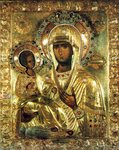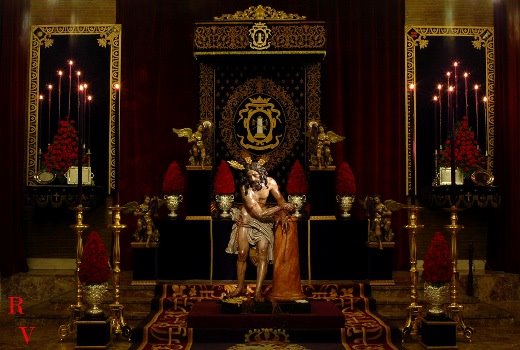
The first time I attended a padasal was on the first anniversary of my grandmother's death, in November of 2005. I had no intention of attending it at all, though; the appointed time was at eleven in the morning, to be preceded by a Mass at her grave at about eight thirty or nine. The drive to the province from Manila would take at least two hours, which meant leaving the house at five thirty. All this, in addition to my disdain for folksy, rural practices more akin to superstition than anything 'right and proper' in the Church's eyes, made me all a bit deracinated.
First, an explanation. A padasal is the commemoration of the death of a loved one, where an abundance of prayers are said for the repose of the soul of the deceased. If you follow traditional Filipino custom, a padasal is held on the anniversary of the death of the deceased, as well as thirty days after the death, and also on the fortieth. It is a time consuming, even monotonous, procedure, one which is invariably more popular with women than with men (there is a reason why food is always served on padasals; it is to keep the men from raising a ruckus and disturbing the concentration of the the mangdarasals). We eventually arrived at the cemetery in the nick of time. The Holy Mass was celebrated by a second cousin of mine, Fr. Erwin, of the Diocese of Lucena. As usual, the Mass was short and sweet; and I recall being righteously proud of the fact that I alone knelt on the moist grass during the Consecration (admittedly most of the attendees were seniors...).
The drive back to my father's house took little over ten minutes. I am always pleasantly surprised at how quickly it takes to navigate cities, even provincial capitals, in the province. There was none of the excruciating traffic so common in Manila, and what little there was could have been negligible. And just as well, as I had not eaten breakfast yet. We arrived home, and already the caterers were posted in the veranda. Among the dishes I noticed were morcon (meat rolls), chicken lollipops, spaghetti, sinigang na baboy (pork cooked in sour broth), as well as some servings of corn soup and rellenong bangus (stuffed milkfish)for the health conscious. Inside, clustered in a circle in the living room, were a group of women ranging from middle aged to the snowy-haired, all immaculately dressed in white. They were whispering amongst themselves and simultaneously drinking coffee. So these were the mangdarasals-- church ladies, who, it seems, are solely preoccupied with structuring their daily activities for prayer. One of them took Fr. Erwin's hand and put it to her forehead, which was followed by several more, until he himself took the hand of one lady-- a rather short and plump schoolteacher with slightly cropped hair.
Breakfast, or should I say brunch, commenced almost half an hour after eleven. At that time I was formally introduced to Fr. Erwin, and yes, 'I was the one who knelt', I proudly told him. We continued talking for about an hour until there was a sudden hush-hush in the living room, and I knew that the padasal had begun. Curious, I excused myself from the table and proceeded to the ghostly group. My mother and father were already there, standing in the corner, while two of my cousins were seated next to an aunt, herself a member of the mangdarasals. The lady whom Fr. Erwin blessed, the schoolteacher, closed her eyes, and produced a rosary from her pocket. Holding the crucifix, she pressed it to her forehead, and in a solemn voice, she began: 'Sa Ngalan ng Ama, at ng Anak, at ng Espiritu Santo.' 'Ave Maria purissima, sin pecado concevida.' 'Bendita sea tu pureza, y eternamente lo sea...'
The words escaped her lips like water falls from a cliff. The steady drone of half-whispered, half-sighed prayers swept over me in all their strangeness and unfamiliarity. Words which were never tossed around in church sermons in the city anymore formed a heavy chain which, I admit, made me uneasy. I knew my grandmother to have been a virtuous woman, who prayed the rosary and read Scripture daily. But purgatory and hell pick no favorites; and eternity has a way of making us remember even the little details of our lives which me would like to think have been buried forever under a slew of psychological coping mechanisms.
They recited all fifteen decades of the holy rosary, ending each series of mysteries with a psalm, a hymn, and especially the prayer of St. Gertrude the Great, said to release a thousand souls from Purgatory every time it is said. At the end of the last series of mysteries (I don't think they prayed the Luminous Mysteries), they sang the hymn 'No mas amor que el Tuyo', followed by the Filipino counterpart of 'On Eagles' Wings', 'Hindi Kita Malilimutan.' Then followed a prayer which was totally alien to me. At a certain point in the prayer, the old lady who led the group instructed two of my aunts to cover their heads; there were no veils handy, so they had to make do with some napkins with cartoon characters printed on them. Apparently, this was supposed to bring good luck and prosperity to the family. This, too, ended. The Litany of Loreto, or perhaps some other litany still unfamiliar to me, was said. After about an hour and a half, the padasal was nearing its completion; the prayer leader took the crucifix into her hand, and, kissing it, began to press it into her forehead again: 'Santong Diyos, Santong Makapangyarihan, Santong walang hanggan, kaawaan Mo po kami at ang buong sanlibutan.' Thrice she did this, before following it with another 'Bendita', and an 'Ave Maria purissima.'
The padasal was finally done, and I saw the old lady take a much needed drink of water after that. The lights were blown off the makeshift altar erected in the living room. It was a simple affair-- a crucifix practically suffocating from garlands of sampaguita, several images of the Virgin, the Santo Nino dressed in its brocade robe, St. Joseph with its garlands of rosaries around its neck, and two huge candles to the side. The ladies in white took off their veils (the one or two who wore them at least)and finally streamed into the dining area, there to make light-hearted 'chismis' (gossip) about the parish priest or a wayward parishioner. At around 3.30 in the afternoon, they left the house, but the fragrance of candle wax and rosaries dipped in rose oil lingered around.
I'm told the format of a padasal can be flexible; and to be honest, I am now not too sure about the exact sequence of prayers uttered that November day some four years ago. But I do remember the enchantment, the strangeness, and yes, the dread mood that came and went with the padasal. I had brought my catechism with me that day, in the hopes of starting a scholarly discussion on the padasal. I never got around to doing that. There was still so much to learn, and I might have just gotten a few laughs thrown at my direction if I did.
























